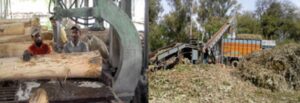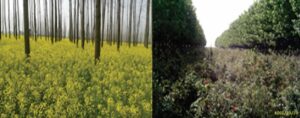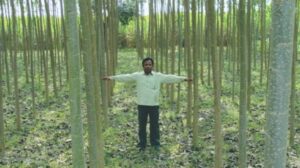
Trees Transitioning from Sacred and Scary Preception to Large Scale Farming for Industrial and Economical Transformation
- March 11, 2024
- 0
Trees and forests are unique gifts to humanity on earth. They are essential elements to maintain oxygen-carbon dioxide balance to sustain life forms which are dependant for the very existence on this vital element on earth. Human association with trees is since time immemorial. This association has always been multidimensional in providing goods and services including shelter & food for survival of mankind during the early civilization phase to expanding role in transforming industrial landscape and economical empowerment in the recent past. Tree’s role in human safety is still significant in this modern era.
Relevant examples of this nature are being repeatedly noticed when floods cause heavy damage to property and life in many locations. Persons while being carried away by fast current flooded waters try to clinch the trees en-route and some of them even save their lives (Fig.-1). These poplar trees have been grown by locals to provide wood for low cost packing cases for quite some times. The contribution of such trees in helping to save the lives in such difficult circumstances is unparallel and beyond their monetary valuation.
Over the centuries, people in many societies have/had developed an extreme psychological impression of good/bad omen for some selected trees. It is believed that such trees being abode of deities are honored for protecting the local people from harm caused by natural disasters or evil influences. Numerous trees encircled with sacred threads, sacred spots made at the base of trees, sacred incent sticks and lights (deepaks) burning at their base, and small stones kept and worshiped there-under could be spotted in different parts of the country.
Many of community protected trees are still not properly documented asides being revered (sacred trees) so much that no one tries to cause any damage to them. From forestry perspective these are considered silvicultural heritage & botanical pilgrimage and represent rare living samples of old and large sized living trees.
In some states, a great emphasis is now being given for their documentation and protection as they are a rich source of biodiversity and wild gene pool. The state of Haryana has started a scheme called “Pran Vayu Devta Pension Scheme” under which 3810 trees aged above 75 years are provided Rs. 2750/ tree each year. The guardians, individuals or Panchayats protecting and looking after them are being paid this pension everywhere.
Beyond sacred/scary value of trees, people gradually started valuing them for their use for wood, fruits, food, and shelter and services. Forest management initiated around 16 decades back in the country mainly focused on exploitation of valuable timber species whereas exploitation of most non timber forest produce remained largely unregulated and as a source of livelihood issue for local inhabitants. Forests were considered as main source of revenue through sale of timber and non-timber produce. Wood based industry started developing around forests mainly with the active support of government agencies. While 1st Indian Forest Policy of 1894 focused on documentation and demarcation of forest resources, 2nd Forest Policy of 1952 laid much emphasis on production forestry especially for industrial wood production leading to expansion of wood based industry in the country.
The last Forest Policy of 1988 saw a departure from the earlier ones which focused on conservation and preservation of forest resources for ecological and environmental consideration rather than wood production.
An attempt was also made to prepare a new Forest Policy around a decade back, its draft was widely circulated for consultation but has yet not been adopted. This draft policy, by and large, retained the core essence of protection aspects as was outlines in 1988 Forest Policy. The WBI was left to make its own arrangement for raw material which they ably did it and facilitated creating a large wood production resource outside government forests especially on farmers fields. This helped the country in evolving a better strategy for taking plantation forestry outside forests ultimately leading to provide a better space for conservation of natural forests and also in meeting its ever increasing wood availability for diverse utilities.

Symbiotic synergy with WBI is key in the success of Industrial AF. left: Billeting poplar at saw mill for match splints-its first established commercial use, Right Lop & top from farm grown plantations (Euca and poplar in this case) being chipped for firewood supply to industry- these trees attaining a status of zero-waste.
Actual beginning of tree farming on appreciable and impactful scale was started by farmers during 1970’s at their own or with support from other agencies. Impactful tree farming was initiated by a Patel family in Gujarat wherein eucalyptus was planted under high density for firewood production which was in higher demand in surrounding locations. The model later on was much advertised and was commonly referred as High Density Energy Plantations (HDEP).
At organizational level, the much discussed poplar farming was started by farmers with the help of match industry for match production in North India around the same period. This is now widely quoted as highly successful tree farming model for industrial wood production. This model soon found appreciation at government levels that folded into the first contract farming model on long gestation tree species wherein loans were arranged from banks, technical know-how and quality planting material supplied by the industry and wood on maturity was procured on already agreed prices.
Soon this model found favour with other wood based industry and they tried this with other tree species and locations. Paper industry replicated this model with eucalyptus for paper pulp and later some major players of panel industry have started promoting tree plantations around their factories in different locations of the country. Punjab and Haryana forest departments also promoted eucalyptus planting on farmer’s fields initially at their own during 1970s but later through externally aided projects.

Farmer-Industry interface and strong symbiotic synergy in growing trees.
It is clear from the above narrations that farmers started and continuing growing trees on their fields due to a constant demand for wood from WBI. Farmers do not find much of their domestic use but mainly grow them for supplying wood to factories. A complete value chain has developed around these trees from growing nurseries & plantations to their harvesting and wood processing in the factories. This relationship between farmers and WBI is evolving and is becoming very strong and unavoidable in the current context with rapid expansion of new wood based industry across the country. Greenlam Industries Ltd. is new entrants in wood panel business this year with one of its upcoming unit in South India started producing MDF. Unlike most other WBI, Greenlam is first of its kind which simultaneously started wood panel manufacturing and promotion of plantations including R&D to support wood raw material production around the vicinity of its factories. The author is associated with this company for technical support in R&D and plantation activities on trees for wood panels.
The bulk of the wood is now produced on farmland. According to an estimate over 90% of wood is produced on farmland, 4% is obtained from the government forests and 6% from imports. Poplar grown on a limited geographical area of North India has been a lifeline for plywood and plyboard industry. According to an estimate around 60% of ply in the country was being produced some time back from its wood. With expansion of panel industry, additional plywood in other parts of the country is now made from other species and eucalyptus is now a major wood for panel products especially MDF and Particle Board. Paper making earlier were totally dependent on wood supplies from government forests and is now largely using farm grown wood from eucalyptus, casuarinas and su-babul. Eucalyptus is now a top planted tree in India and is economically empowering lakhs of farmers of them across the country.

Planting model and integration of agriculture crops are evolving over the years.
The old proverb “MONEY DOES NOT GROW ON TREES” has lost its relevance and this is virtually happening now. Famers are now growing trees for money which they have been doing it for 4-5 decades.
It is generally believed that cost of production in poplar based agroforestry is recovered from sugarcane and other crops grown with it and the sale value of trees provides net returns to growers. There are now many reports that poplars in north India (around 90%) is routinely harvested between 3 to 3.5 years with some stray cases of harvesting at below 2 years age and around 5% over 5 years age. In the recent past, a farmer in Roop Nagar District of Punjab has sold 5 acre poplar of 5 years for Rs. 45 lakhs and the net returns from it are touching Rs. 2 lakh/acre/year and that of eucalyptus as Rs.70000/acre/yea.
Symbiotic synergy with WBI is key in the success of Industrial AF. Two essential ingredients in the success of farm wood production are strong R&D support and effective extension. Planting model and integration of agriculture crops are evolving over the years. The production models with poplar and eucalyptus shown in these pictures are from different parts of North India which is undertaken by farmers themselves. A mention is made of the last photo of roses grown in poplar plantation that was undertaken around 2 decades back by a progressive farmer of Ludhiana District of Punjab who had a small cottage scale distillation unit to extract incense from flowers. At that time farmer was reportedly getting Rs. 2 Lakh/acre/year net returns from the combined production system and the returns from sale of essence oil extracted from flowers was much higher than traditional crops.
Economic returns from growing trees are gradually increasing with increase in wood prices. The harvesting period for poplar was fixed as 20 years when it was first introduced in India. It has gradually declined initially to 12 years than 8 years and now many farmers are harvesting it anytime from 2-6 years based on their experience and market conditions. Similarly, in case of eucalyptus majority of its plantations grown for paper pulp and panel manufacturing are now harvested at 4 years age.

“Greed Thrills but Kills”.
Planting too many plants per unit area taxes the growers and affects the wood production of desired quality and quantity significantly decline in high density plantations. The plantation shown in the photo is that of a U.P. farmer who planted 600 plants/acre which is beyond recommended number. The situation is worst in case of Eucalyptus where some farmers plant upto 4000 plants/ha in some locations. This kind of greed is against biological and silvicultural principles of tree productivity.
Conclusion
The story presented here indicates that the human behavior in relation to tree conservation and production is constantly evolving. There is a gradual dilution of haunting and scary nature of trees but their psychological connect for reverence is still deep rooted in the society. The gradual transition of our association with trees from shelter to safety, scary, haunting, sacred, other goods & services and finally their large scale farming leading to industrial development landscape and economical transformation is very interesting and helping a great deal in transforming rural India. There is no parallel example of such a large wood resource created and managed on farmland by small farmers in any other country around the world.
👇 Please Note 👇
Thank you for reading our article!
If you want to read our daily articles, news & industries updates,
please Whatsapp your Wapp No. or V Card on 8278298592, your number will be added in our broadcasting list.

































































